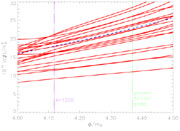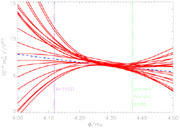


5.1. The current status of inflation
The best available constraints come from combining data from different sources; for two recent attempts see Wang et al. [1] and Efstathiou et al. [11]. Suitable data include observations of the recent dynamics of the Universe using Type Ia supernovae, cosmic microwave anisotropy data, and galaxy correlation function data such as that described by Lahav and by Frieman in these proceedings.
Currently inflation is a massive qualitative success, with striking agreement between the predictions of the simplest inflation models and observations. In particular, the locations of the microwave anisotropy power spectrum peaks are most simply interpretted as being due to an adiabatic initial perturbation spectrum in a spatially-flat Universe. The multiple peak structure strongly suggests that the perturbations already existed at a time when their corresponding scale was well outside the Hubble radius. No unambiguous evidence of nongaussianity has been seen.
Quantitatively, however, things have some way to go. At present the best that has been done is to try and constrain the parameters of the power-law approximation to the inflationary spectra. The gravitational waves have not been detected and so their amplitude has only an upper limit and their spectral index is not constrained at all. The current situation can be summarized as follows.
 H
H H = 1.9 ×
10-5
H = 1.9 ×
10-5
 0-0.8
on a scale close to the present Hubble
radius (see Refs.
[12,
4]
for accurate formulae).
0-0.8
on a scale close to the present Hubble
radius (see Refs.
[12,
4]
for accurate formulae).
It remains possible that future observations will slap us in the face
and lead
to inflation being thrown out. But if not, we can expect an incremental
succession of better and better observations, culminating (in terms of
currently-funded projects) with the Planck satellite
[13]. Faced
with observational data of exquisite quality, an initial goal will be to
test
whether the simplest models of inflation continue to fit the data, meaning
models with a single scalar field rolling slowly in a potential
V( ) which
is then to be constrained by observations. If this class of models does
remain
viable, we can move on to reconstruction of the inflaton potential from the
data.
) which
is then to be constrained by observations. If this class of models does
remain
viable, we can move on to reconstruction of the inflaton potential from the
data.
Planck, currently scheduled for launch in February 2007, should be highly accurate. In particular, it should be able to measure the spectral index to an accuracy better than ±0.01, and detect gravitational waves even if they are as little as 10% of the anisotropy signal. In combination with other observations, these limits could be expected to tighten significantly further, especially the tensor amplitude. Such observations would rule out almost all currently known inflationary models. Even so, there will be considerable uncertainties, so it is important not to overstate what can be achieved.

|

|
Figure 3. Sample reconstruction of a
potential, where the
dashed line shows the true potential and the solid lines are thirty
Monte Carlo
reconstructions (real life can only provide one). The upper panel shows
the potential itself which is poorly determined. However some
combinations, such as
(dV / d |
Reconstruction can only probe the small part of the potential where the
field rolled while generating perturbations on observable scales. We know
enough about
the configuration of the Planck satellite to be able to
estimate how well
it should perform. Ian Grivell and I recently described a numerical
technique which gives an optimal construction
[14].
Results of an example
reconstruction are shown in Figure 3, where it
was assumed that the true potential was

 4. The potential
itself is not well determined
here (the tensors are only marginally detectable), but certain
combinations, such as
(dV / d
4. The potential
itself is not well determined
here (the tensors are only marginally detectable), but certain
combinations, such as
(dV / d ) /
V3/2, are
accurately constrained and would lead to high-precision constraints on
inflation model parameters.
) /
V3/2, are
accurately constrained and would lead to high-precision constraints on
inflation model parameters.